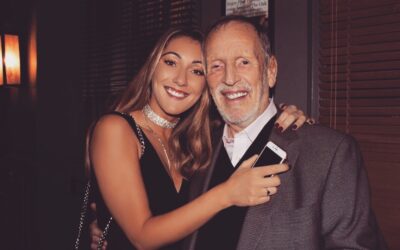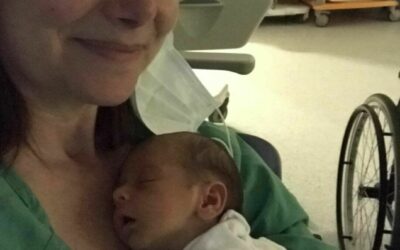I have just finished reading Oliver Sacks’ book Hallucinations and have finally got an answer to my questions about a number of symptoms that have been plaguing me since 1997 and which at times, when I have spoken about them to my doctors, have led to exceedingly negative reactions (mainly being told I was pretending or suffering from psychosomatic problems). I think my case history might be of assistance to other suffers of chronic inflammatory demyelinating polyneuropathy in coping with the weirdness of their symptoms and so have sent it to you.
In early October 1997, at the age of 39, I awoke at 6 o’clock to my alarm clock feeling really strange in my body. My fingertips, toes, lips and the tip of my tongue were tingling and my nose felt like it had changed into a huge potato. Being a veterinary surgeon, my thoughts were “What the hell?” and then “What’s the disease?” I knew that tingling in many nerve endings at the same time would be indicative of polyneuropathy, but I could not understand what had happened to my nose. Looking in the mirror, I saw that it was its usual long and rather pointed form, not the large rotund protuberance which I could feel. Fingering my my nose did not change my abnormal sense of feeling.
As I was that morning going down to Munich to take my three-year-old son to his grandparents so I could attend a conference on environmental toxins in Granada and as I felt otherwise well, I decided to ignore the symptoms and fly off to Spain. I had an enjoyable time at the conference and in the Alhambra, but with each successive day the tingling crept up my extremities and after a week had reached my elbows, knees and was covering the whole of my face. The potato was still firmly in place.
On getting back home to Goettingen, 12 days after starting the symptoms, I went to a neurologist. He listened very intently to my story and asked me questions about my life (summary: middle-aged female, single mother, scientist, no sex for 4 years). The more my story came out, the more the doctor looked pleased with himself (at this point I must say he did not at any time lay a hand on me to check my reflexes, etc). He told me, “I was reacting to the problems of my life” (I said I thought I was having a good time; he said I was in denial) and “I could myself see as an intelligent woman that my nose was neither the shape nor the size of a large potato”. He went on to say that I was showing a psychosomatic response to my life style and this form of problem (read “hysterical female syndrome”) was to be treated with valium. The neurologist was not happy when I refused the valium saying that I had had it once and had a paradoxical reaction to it and so did not think it would help me but rather hinder me in functioning. I think he thought I was just being an awkward smart ass. He did say I was being unreasonable and that I should at least take St. John’s Wort, which is apparently commonly prescribed here in Germany for mild to middling depression. I had declined and left his practice, vowing never to return.
Luckily, I had (and have) a very dear friend who is a neurologist over in the USA, so I rang him. After telling him my symptoms and using him as a sounding board for my rage at being designated a “hysterical female”, he rang one of his former colleagues working at the university hospital in Goettingen and asked him to see me. John told him that “she may be eccentric & a little crazy but she is not hysterical”. Within 30 minutes of my being at the hospital, a CSF sample was taken and the Pandy’s test revealed a dense milky precipitate. I was given the diagnosis of chronic inflammatory polradiculoneuropathy, but as I could function despite the sensory disturbances I went home. My feeling of having a potato in my face was ignored and I did not push it.
Five weeks later, the concomitant progressive muscle paralysis was so extreme, I had to be hospitalised and I was given the diagnosis of chronic Guillain-Barre syndrome/ Chronic inflammatory demyelinating polyneuropathy (CIDP)/ chronic relapsing polyneuropathy (CRP) – it is nice to have a disease with so many names, it makes one feel important! Cortisone was started and the doctors and I waited to see if my weakening respiratory muscles would give up and I would need a respirator. Luckily, that did not happen and I went to a convalescence home roughly three months later.
During my time at the hospital after the cortisone was started, I developed excruciating pain in my hands and feet (though I did not have any other sensations there). The neurology professor said that was impossible and made no suggestions as to how I should cope with the pain. He seemed rather annoyed with me for complaining about it. Luckily for me, one of his junior doctors had given a breakfast lecture whilst on an internship in a Californian hospital on pain in GBS patients and although he did not contradict his professor, he kindly gave me a copy of his paper on his way home that evening. Armed with this (high percentage of such patients suffer the pain I was having to deal with, so I was not alone), I contacted both the British GBSSG and a shiatsu practitioner in Goettingen to find out what I could do to help myself. My shiatsu therapist showed me how to stimulate certain pressure points on my hands despite my fine motoric problems and this technique, in addition to the use of lavender oil massages to my extremities (according to the GBS people), was actually very effective. The doctors in the hospital just let me get on with it, though some were rather unbelieving at the need for this therapy or its efficacy. I had by this time learnt not to talk openly about my peculiar symptoms to my doctors, just about the lack of proprioception – things they could measure and test.
During my time at the convalescence home, my muscles got stronger though my sensory deficits remained. One day whilst strolling around with my wheeled frame in the common room, I felt an earthquake. As I had already been in a mild earthquake some years previously, I looked up at the chandeliers only to see that they were not moving. As my fellow patients were all quietly sitting, talking or reading and were not showing any signs of shock which an earthquake would cause, I assumed that this feeling was the start of the sensory nerves in my legs beginning to conduct properly again. I was so happy I talked to the ward doctor, reaping a rather stony stare and no comment. My physiotherapist was more helpful; she said yes that was a normal “abnormal” feeling. The earthquake came on and off for about a week before subsiding. Again, my sensory deficits all over my body were otherwise complete.
Over the past 16 years my sensory deficits have for the main part gone, though if it is dark I tend to fall over as I need to see the ground to adjust my steps. I tingle and have formication all over my face and lower arms and feet if I get excessively tired, which is a state I often achieve if I do not pace myself properly. This leads to an inability to feel things correctly until I have rested and the parathaesia has gone. If I did not concentrate, I let things fall out of my hands, though after many years of practising I can knit again (learning to do the knit again (learning to do the knit stitch took about six months, the purl stitch nearly two years). Normal pain and superficial touch sensations took more than five years to return – sadly, the first part being my stump on d2 of my right hand (it would have been nice if my brain could have forgotten about that). I sometimes also get amazingly violent electro shocks from my toes/ feet which make me jump, though if I can force myself to relax they last only for a few seconds to a couple of minutes. The sudden jumping in my seat (it seems to occur when I am sitting down relatively quietly, like at an official meeting) is embarrassing as it surprises my neighbours. I have learned to just say “my slipped discs are troubling me” (I have six) as that is more believable than saying my nerves are playing up as the latter tends to glean me strange looks.
For the most part, my body awareness is relatively normal until I go rambling. I loved to ramble before I became paralysed, but now it is virtually a spiritual need to be out and about in the countryside. Usually, I just walk an hour or two with the dog each day. However, I am a member of a rambling club and a couple of times a year, when I am feeling fit enough, I go with them. We walk 25 km plus per day. In the morning I am quick and as long as I look at the ground fairly sure-footed, but after about 10km a strange sensation occurs – I feel as if my legs and feet below my knees have turned into thick concrete boots. I start to walk broad-legged like a sailor, with each step having to be a well-thought-out process- the normal walking automation is virtually gone. there is no sign of any swelling in either my legs or feet. Once I have slept, and I sleep well, this feeling is gone. Many of the people I walk with are neurologists but I have been too cowardly to tell them of this change.
Now, after Sacks’ book hallucinations, I think that much of my dysaesthesia is due to hallucinations of my poor brain having to deal with a very wonky peripheral nervous system. It would have made my life easier if my doctors had realised this earlier and had not repeatedly given me the feeling that I was mentally abnormal and not just ill with an autoimmune disease. The idea that one could really be “hysterical” or even “mad” because something that others cannot see or measure is causing one problems is difficult to cope with, even for someone as self-confident and fairly well informed as myself.
Teresa Gatesman



